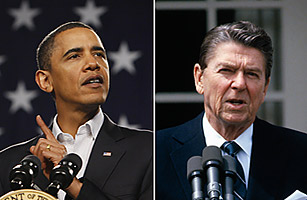
In May 2010, Barack Obama invited a small group of presidential historians to the White House for a working supper in the Family Dining Room. It was the second time he’d had the group in since taking office, and as he sat down across the table from his wife Michelle, the President pressed his guests for lessons from his predecessors. But as the conversation progressed, it became clear to several in the room that Obama seemed less interested in talking about Lincoln’s team of rivals or Kennedy’s Camelot than the accomplishments of an amiable conservative named Ronald Reagan, who had sparked a revolution three decades earlier when he arrived in the Oval Office. Obama and Reagan share a number of gifts but virtually no priorities. And yet Obama was clearly impressed by the way Reagan had transformed Americans’ attitude about government. The 44th President regarded the 40th, said one participant, as a vital “point of reference.” Douglas Brinkley, who edited Reagan’s diaries and attended the May dinner, left with a clear impression that Obama had found a role model. “There are policies, and there is persona, and a lot can be told by persona,” he says. “Obama is approaching the job in a Reaganesque fashion.”
When Obama stood before Congress, the Cabinet and the American people to deliver his second State of the Union address, both the Reagan persona and policies put in appearances. He proposed a freeze in discretionary spending and federal salaries, a push to simplify the tax code and billions in cuts to the defense budget, and he made new calls for a bipartisan effort to repair Social Security. Each of these had been proposed before by another third-year President coming off a midterm defeat in a period of high unemployment. “Let us, in these next two years — men and women of both parties, every political shade — concentrate on the long-range, bipartisan responsibilities of government,” Reagan said in his 1983 State of the Union, “not the short-range or short-term temptations of partisan politics.”